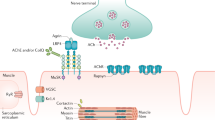Abstract
Injury of afferent motor axons or pathological loss of motoneurones from the spinal cord causes the remaining axons within a muscle to sprout and to reinnervate the denervated muscle fibres. Sprouting occurs at two sites along intramuscular axons, at nodes of Ranvier (nodal sprouting) and at the neuromuscular junction (terminal sprouting)1,2. Terminal sprouting is also produced by treatment with botulinum toxin and by other agents that render muscle inactive3–7. The muscle probably provides a signal for terminal sprouting as restoration of muscle activity by direct electrical stimulation prevents sprouting8–10. Such a signal might be a local change on the muscle fibre surface or a ‘soluble’ sprouting factor2,4, although the failure to induce terminal sprouting in one muscle by denervating adjacent muscles argues against the latter hypothesis11–13. I now report that rabbit antisera against a 56,000 (56K)-molecular weight protein secreted by denervated rat muscle suppress botulinum toxin-induced terminal sprouting in the mouse gluteus muscle. An immune response against this protein has also been detected in serum of patients with amyotrophic lateral sclerosis (ALS), a disease in which loss of motoneurones from the spinal cord is not accompanied by the degree of sprouting and reinnervation seen in other motoneurone diseases14.
This is a preview of subscription content, access via your institution
Access options
Subscribe to this journal
Receive 51 print issues and online access
$199.00 per year
only $3.90 per issue
Buy this article
- Purchase on Springer Link
- Instant access to full article PDF
Prices may be subject to local taxes which are calculated during checkout
Similar content being viewed by others
References
Edds, M. V. Q. Rev. Biol. 28, 260–276 (1953).
Brown, M. C., Holland, R. L. & Hopkins, W. G. A. Rev. Neurosci. 4, 17–42 (1981).
Brown, M. C. & Ironton, R. Nature 265, 459–461 (1977).
Betz, W. J., Caldwell, J. H. & Ribchester, R. R. J. Physiol., Lond. 303, 281–297 (1980).
Duchen, L. W. & Tonge, D. A. J. Anat. 124, 205–215 (1977).
Holland, R. L. & Brown, M. C. Science 207, 649–651 (1980).
Duchen, L. W. & Stritch, S. J. Q. J. exp. Physiol. 53, 84–89 (1968).
Ironton, R., Brown, M. C. & Holland, R. L. Brain Res. 156, 351–354 (1978).
Brown, M. C., Holland, R. L. & Ironton, R. J. Physiol., Lond. 306, 493–570 (1980).
Brown, M. C. & Holland, R. L. Nature 282, 724–726 (1979).
Weiss, P. & Edds, M. V. Am. J. Physiol. 145, 587–607 (1946).
Van Harreveld, A. Am. J. Physiol. 150, 670–676 (1947).
Brown, M. C., Holland, R. L., Hopkins, W. G. & Keynes, R. J. Brain Res. 210, 145–151 (1980).
Stålberg, E. in Human Motor Neuron Diseases (ed. Rowland, L. P.) 47–59 (Raven, New York, 1981).
Stålberg, E., Schwartz, M. S. & Trontelj, J. V. J. neurol. Sci. 24, 403–415 (1975).
Swash, M. & Schwartz, M. S. J. neurol. Sci. 56, 185–197 (1982).
Schwartz, M. S. & Swash, M. Acta neurol. scand. 65, 424–431 (1982).
Butler, R. C., Gawel, M., Rose, F. C. & Sloper, J. C. in Motor Neuron Disease (ed. Rose, F. C.) 79–93 (Churchill-Livingston, London, 1976).
Schwartz, M. S., Stålberg, E. & Swash, M. J. Neurol. Neurosurg. Psychiat. 43, 150–155 (1980).
Gurney, M. E., Belton, A. C., Cashman, N. & Antel, J. P. Neurology 33, (Suppl. 2), 155 (1983).
Dribin, L. B. & Barrett, J. N. Devl Brain Res. 4, 435–441 (1982).
Henderson, C. E., Huchet, M. & Changeux, J.-P. Proc. natn. Acad. Sci. U.S.A. 78, 2625–2629 (1981).
Hopkins, W. G. & Slack, J. R. J. Neurocytol. 10, 537–556 (1981).
Brown, M. C. & Ironton, R. J. Physiol., Lond. 278, 325–348 (1978).
Merlie, J. P., Heinemann, S. & Lindstrom, J. M. J. biol. Chem. 254, 6320–6327 (1979).
Laemmli, U. K. Nature 227, 680–695 (1970).
Towbin, H., Staehelin, T. & Gordon, J. Proc. natn. Acad. Sci. U.S.A. 76, 4350–4354 (1979).
Nie, N. H., Hull, C. H., Jenkins, J. G., Steinbrenner, K. & Bent, D. H. in Statistical Package for the Social Sciences (McGraw-Hill, New York, 1970).
Author information
Authors and Affiliations
Rights and permissions
About this article
Cite this article
Gurney, M. Suppression of sprouting at the neuromuscular junction by immune sera. Nature 307, 546–548 (1984). https://doi.org/10.1038/307546a0
Received:
Accepted:
Issue Date:
DOI: https://doi.org/10.1038/307546a0
This article is cited by
-
The neurotrophic factor neuroleukin is 90% homologous with phosphohexose isomerase
Nature (1988)
-
Intramuscular nerves in motor neurone disease
Acta Neuropathologica (1988)
Comments
By submitting a comment you agree to abide by our Terms and Community Guidelines. If you find something abusive or that does not comply with our terms or guidelines please flag it as inappropriate.



